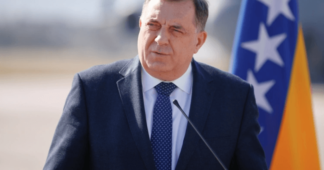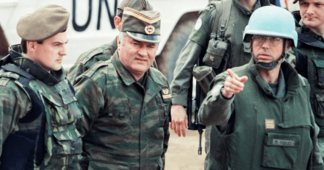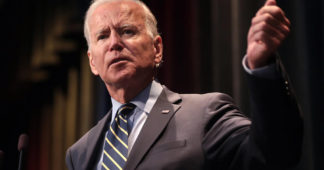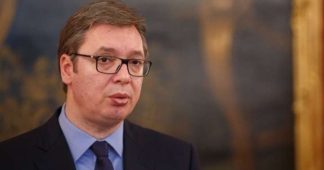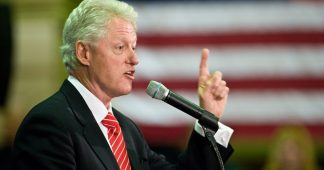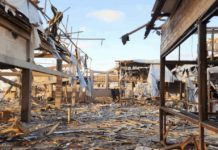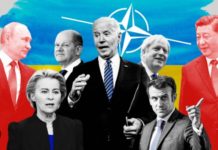By Seán Mac Mathúna
“A few days ago Mr. Boutros Ghali informed me that the projectile which hit the Markale marketplace in Sarajevo was an act of (Bosnian) Muslim provocation”. President Mitterrand of France, 1995
Open military confrontation in Bosnia-Herzegovina ended with the signing of the Dayton Peace Agreement on 14th December 1995. The conflict had resulted in more than 160,000 deaths, and 2.5 million refugees and displaced persons. Not long before, the United Nations (UN) had ordered the first combat units from its rapid reaction force into Sarajevo, after after Serb rebels killed two French peacekeepers. Three Bosnian Serb shells had hit the French and Danish areas of a U.N. compound in Zetra, north of Sarajevo’s centre killing a French peacekeeper and wounding another French soldier and a Dane. A half-hour later, another French peacekeeper was killed and two wounded, one seriously, when a U.N. convoy was targeted by Serbs in the suburb of Butmir. The deaths brought the number of French dead to 42 since the Bosnian war began in April 1992 – and not all of them were killed by the Bosnian Serbs, a number of them were also killed in crossfire or deliberately by the forces of the Bosnian government.
Not only did the UN get tough with the Bosnian Serbs – whose political and military leaders have now been charged with war crimes – in 1995, NATO had become directly involved when when they ordered air strikes against the Bosnian Serbs. These attacks had been preceded by a series of barbaric attacks against civilians in the Markele market in Sarajevo, all of which were assumed to be the work of the Serb army laying siege to Sarajevo.
There were three attacks on the markets, all of which were blamed on them: the first on 27th May 1992, killed 16 people, the second on 5th February 1994 killed 68, and the third on 28th August 1995, killed 37. The last attack is the most significant, as it has been widely alleged, by members of the UN Mission in Bosnia, UN Commanding officers and of course, predictably, the Bosnian Serbs themselves, that this one in particular was staged by elements within the Bosnian government to provide the pretext for NATO military involvement in the war. In subsequent attacks, bombs and bullets used by the NATO jets used Depleted Uranium (DU) which is now estimated to have claimed the lives of some Serb 300 civilians who lived in the vicinity of the bases hit by NATO, according to reports that surfaced in 2001. What evidence is there for the claims that the Bosnian government carried out these attacks?
The first attack in 1992
The first of three attacks happened on 27th May 1992 when 16 people killed in a “mortar attack” on a bread queue in Vase Miskina street in Sarajevo. As The Independent (22nd August 1992) noted, the televised scenes of civilians cut to pieces by an explosion as they queued for bread horrified international public opinion, and added growing pressure for NATO to “intervene” in the civil war against the Bosnian Serbs. Vivid footage showed dead bodies littering the street and “terrified crying people sitting on the pavement in pools of blood”. The attacks came shortly before a meeting by European Union ambassadors to consider imposing sanctions on the Federal Republic of Yugoslavia. UN officials from the start were “suspicious about the circumstances but would not go public with their thoughts without jeopardising the UN mission” in Bosnia. Classified reports given to the commander of the UN peace keepers, General Satish Nambiar, concluded that it was likely that the army of the Bosnian government in Sarajevo carried out the attack. In fact, they were reported to believe it wasn’t a mortar attack at all but a “command-detonated explosion – probably in a can”. The impact mark left by the “mortar” on the market square floor was nowhere “near as large as we came to expect with a mortar round lading on a paved surface”. This is also supported by another UN commander in Bosnia, General Michael Rose of the British army, who according to his book Dispatch the Bosnian government in Sarajevo shelled their own people to get a military response by NATO against the Bosnian Serbs (The Observer, 28th March 1999). NATO launched air strikes against the Bosnian Serbs as a result of this attack.
According to The Independent, United Nations (UN) officials and senior Western military officers believe that the attack in 1992 was carried out by the Bosnian government, “To win world sympathy and trigger intervention”. This was also expressed in confidential reports circulating at the UN headquarters in New York, and in classified briefings to US policy makers in Washington, according to the British newspaper. The attack on the bread queue in Vase Miskina Street also led to draconian sanctions against Yugoslavia imposed by the Security Council (resolution 757) on 30th May 1992 (which had been preceded by Yugoslavia’s expulsion from the WHO). All supplies of raw materials to the well-developed pharmaceutical industry of Yugoslavia for production of medicines were immediately suspended. The justification for blaming Yugoslavia for attacks carried out in Bosnia was based on Western intelligence disinformation that the country was directing the war on behalf of the Bosnian Serbs.
The second attack in 1994
The second attack on a market in Sarajevo happened on 5th February 1994 when a single mortar round left 68 dead and 200 wounded. Some people immediately questioned how son many civilians had been killed or wounded by one mortar bomb. Furthermore, officials from the Bosnian government did allow anyone from UNPROFOR to verify what had happened. Despite vehement denials from the Bosnian Serbs, the US news channel, CNN, immediately reported that they were responsible for the shocking carnage that the attack left, which CNN claimed was “caused by a Serb mortar bomb”. The US President Bill Clinton added to this saying it was “highly likely” that the Bosnian Serbs were responsible for it.
Thus, US ambassador to the UN, Madeline Albright and the US presidential security advisor Anthony Lake, immediately called for NATO air strikes against the Bosnian Serbs. Yet there were already people claiming that even the UN itself did not suspect the Bosnian Serbs, but this appears to have been suppressed by the Western media, possibly acting under covert British and American pressure, assuming the the whole purpose of the mortar attack was to provide the pretext for NATO military involvement in the Balkans for the first time. If this is not the case, then it is certainly hinted at by the former British Foreign Secretary David Owen in his book Balkan Odyssey (Victor Gollanz, London, 1995):
“People around General Rose never tried to hide the fact that at his meeting with Bosnian Muslim leaders (President Alia Izetbegovic and General Delic) he said that he had just received some information which shows that the mortar bomb did not come from the area under Serb control but from the Muslim part of the city . . .”
However, Owen’s account of the the Market square massacre in 1994 has been criticised by Noel Malcom in a review of his book in The Sunday Telegraph on 12th November 1995.
When discussing the market-place massacre in Sarajevo of February 1994, Lord Owen goes on at length about a UN investigation which concluded that the mortar shell had been fired from a Bosnian Government position. Dramatically, he confirms that General Rose put pressure on Bosnian ministers by threatening to reveal this finding, unless they did as they were told. What Lord Owen does not tell us is that a second, more thorough investigation found that the first had made mistakes in its calculations, and concluded that the shell could equally have come from the Serb side. It is surely inconceivable that Owen is unaware of this second report; yet he chooses not to mention it. Readers will have to draw their own conclusions about the overall reliability of this grotesquely vainglorious book.
But, Owen also fails to give any clear evidence as to the perpetrators of this attack – if you read his statement carefully, he is only telling us that the second investigation, although on one hand, described as “more thorough”, still concluded that the shell could “equally” have come from the Serb side. This indicates to me that their is still no hard evidence that either side were responsible. Bosnian Serb and Russian claims should be treated with scepticism (as they have a vested interest, from a propaganda point-of-view, in making sure these allegations are widely circulated). But the claims of the UN and representatives of various NATO countries serving as peacekeepers should be treated as serious and worthy of investigation.
From example, On 6th June 1996, Yasushi Akashi, UN special envoy for Bosnia, told a German journalist working for DPA in New York, that there was a secret UN report accusing the Bosnian government forces of this massacre. It was claimed that this secret report was passed on to the UN Secretary General, Boutros Boutros Ghali, who did not publish it in the interest of “higher politics”. Citing this UN report, B. Volker, a French journalist working for TV TF1 said that the mortar bomb was fired from Bosnian government positions. Volker also quotes the words of President Mitterrand: “A few days ago Mr. Boutros Ghali informed me that the projectile which hit the Markale marketplace in Sarajevo was an act of (Bosnian) Muslim provocation”.
The third attack in 1995
The third attack, on 28th August 1995 also hit market and left 37 dead and 90 wounded. When UN issued a declaration blaming the Bosnian Serbs, it evidently ignored the report of the British and French experts as well as the assessment of the UN’s artillery expert for the Sarajevo sector, a Russian colonel, A. Demurenko. Soon after the attack, NATO launched extensive air strikes against Bosnian Serb military and civilian targets. The strategy appeared pre-planned as it coincided with an joint Croat and Bosnian government offensive against the Bosnian Serbs. The attacks changed the course of the war in Bosnia as enabled NATO to enter the conflict on behalf of the Bosnian government and Croat forces. After this attack, President Yeltsin gave official credence to reports circulating in the Russian media that a “third party” was responsible for the mortar attack on the bread queue. Yeltsin said that Russia “insists” that the UN “look again” at the attacks as there was new evidence indicating that it was not the Bosnian Serb’s who carried out the attack. Despite this, NATO went ahead and launched air strikes. One military adviser to the foreign ministry, General Boris Gromov, even claimed (with no evidence provided) that one of the NATO powers was involved in the mortar attack “as a provocation”. Yeltsin also said:
“Why am l against the expansion of NATO ? This (mortar attack in Sarajevo) is the first sign of what might happen when NATO comes right up to the borders of the Russian Federation. Those who insist on the expansion of NATO are making a major political mistake. The flame of war would burst out across the whole of Europe” (The Guardian, 9th September 1995).
The Russians and Bosnian Serbs have claimed that the third attack was prepared in advance over many months by “certain” Western secret services (probably including the CIA), and that Bosnian government troops under the commander of the General R. Delic carried it out. The reason for this, they argue, was to provide NATO with an opportunity not only discredit the Bosnian Serbs, but to provide the pretext to use heavy air strikes on them so as to destroy their military potential. The Russian intelligence service (FSB) were said to had known about the preparation of the plan since February 1995. Then a detailed plan, allegedly called Cyclone 2, was related to a secret memorandum, signed on 10th August 1995 at the Pleso airport in Zagreb, Croatia. The memorandum was signed for the UN by the commander of the UNPROFOR forces based Croatia and Bosnia,General B. Janvier and by Admiral L. Smith for NATO. This secret memorandum was only passed on, as “secret”, on 13th September 1995 to the UN Security Council, when the main destruction of Serb targets had already taken place. According to article 7 of the memorandum UNPROFOR agreed to provide all information necessary for the NATO strikes against Serb targets to achieve the maximum success.
According to the FSB, the mortar was fired from the roof of a building near the market and they further claimed that the device was not a standard mortar bomb. Another author, Y. Bodansky, the director of the Republican parliamentary task force studying terrorism and unconventional warfare (Target America, Terrorism in the US Today, S.P.I. Books, Shapolsky Publishers, New York, 1993), believed that the Bosnian Serb intelligence service knew that “something was being planned” in Sarajevo. On 26th August 1995 (two days before the second massacre) he spoke by telephone to a senior official of the Republika Srpska in the Yugoslav capital, Belgrade, who told him anxiously that once again “something terrible is being planned against the Serbs” in Sarajevo. How much of this is true, made up or just a joint FSB-Bosnian Serb disinformation campaign is hard to assess.
Another report indicating that the Bosnian Serbs were not responsible for this market place attacks was published in The Sunday Times on October 1st 1995. It claimed that British ammunition experts serving with the UN in Sarajevo had “challenged” key evidence of the attack on the bread market which not only triggered NATO attacks against the Serbs in Bosnia, but turned the tide of the war against them. According to the newspaper, the British experts:“found no evidence that the Bosnian Serbs had fired the lethal round”
Nora Beloff, writing in her book Yugoslavia: An Avoidable War (New European Publications, London, England, 1997), also allege that “that Bosnian government arranged to kill their own people” so as to get the Bosnian Serbs blamed. She alleges the news reporter Martin Bell, now an independent MP in Britain, had known about these allegations through his contacts with British UN officers but “he ignored what they might have told him”. She repeats claims, as reported in David Owen’s account of the bombings, that western experts had discovered that it was the Bosnian government forces and not the Bosnian Serbs who had been behind the attack in February 1994. Allegedly, when UNPROFOR wanted the Bosnian government to participate in truce negotiations, the British commander, General Michael Rose: “Blackmailed the Bosnian Muslim leaders into submission. He told them that unless they agreed to cooperate, he would tell the international press that he had technical expertise proving that the grenade came from the Muslim, not the Serb, side” (Beloff, p112/113).
Other attacks supposedly carried out by the Bosnian government – and blamed on the Bosnian Serbs – include:
- 29th June 1992: Rocket attack on Sarajevo’s TV station kills 5 people. Bosnian government troops implicated in this attack (The Sunday Times, October 1st 1995).
- 17th July 1992: A “choreographed” mortar salvo, 30 seconds after British Foreign Secretary Douglas Hurd entered a building for a meeting with the Bosnian President, Alija Izetbegovic. The attack killed or wounded 10 bystanders – but not Hurd’s guard of honor, who had clearly been forewarned and ducked for cover seconds before the attack.
- 4th August 1992: Bomb attacks which were filmed by the Western film crews at a funeral of two orphans in a cemetery in Sarajevo. The attacks were blamed on the Bosnian Serbs.
- 13th August 1992: After the Yugoslav Prime Minister Milan Panic arrives in Sarajevo airport for a meeting with Izetbegovic, a Bosnian government sniper kills US TV producer David Kaplan. The attacks disrupts the schedule of Panic, and he only manages to spend 20 minutes on the phone with Izetbegovic.
Philip Corwen, a senior member of the UN in Bosnia has recently written a book about his experience there (Dubious Mandate: A memoir of the UN in Bosnia, Summer 1995 [Duke, London, UK, 1999]): “The French forces (the main UN armed force in Sarajevo) were continually harassed, shot at, blocked at, and threatened by Bosnian government forces . . . it was the French who pointed out that the Bosnian government was placing weapons systems next to UN facilities in order to draw fire from Serb artillery onto civilian and UN targets and thus provoke international outrage against the Serbs . .. (p178)
I recommend that readers interested in the background to the conflict in Bosnia read Corwen’s book: His meticulous account shatters once and for all the “one victim – one enemy” myth promoted mainly by the Western media. For the record, l unequivocally condemn the war crimes and crimes against humanity carried out by the Bosnian Serb regime against the people of Sarajevo – whom they relentlessly bombed and shelled. The Bosnian Serb leaders Radovan Karadzic and General Ratko Mladic have been rightfully indicted by the International war crimes tribunal in the Netherlands – but why has this tribunal failed to indict Alija Izectbegovic, the Bosnian President and other senior officials of his government when there is clearly enough prima-facie evidence of their complicity in war crimes carried out by the Bosnian army ? I believe that the UN probably has ample evidence to show that the Bosnian government carried out these attacks in Sarajevo, but along with NATO, decided not to pursue charges against Bosnian government leaders for political reasons, and decided to sweep the whole story under the carpet and suppress it.
Footnote: an estimated 300 civilians killed after NATO used depleted Uranium in reprisal attacks
“Up to 300 men, women and children who lived close to the site of the (NATO) bombings in 1995 have died of cancers and leukemia over the last five years”. Robert Fisk, 2001
Finally the bombings of the market place unleashed a wave of NATO air-strikes against Bosnian Serb military targets in and around Sarajevo. In these attacks, bombs and bullets used by the NATO jets used Depleted Uranium (DU) that is now estimated to have claimed the lives of some Serb 300 civilians who lived in the vicinity of the bases hit by NATO. According to Robert Fisk, writing in The Independent of Sunday on 14th January 2001, NATO subjected the Serb military bases and surrounding civilian areas to an intense bombardment between 30th August to 15th September 1995, using jets and artillery from Mount Igman just outside Sarajevo. Civilians living in the area surrounding the bases starting to begin suffering from a variety of symptoms now linked to the use of DU by NATO in Bosnia. NATO governments have so far shown little interest in helping the civilian victims of DU in either Bosnia, Yugoslavia or during the assault on Iraq in 1990.
We remind our readers that publication of articles on our site does not mean that we agree with what is written. Our policy is to publish anything which we consider of interest, so as to assist our readers in forming their opinions. Sometimes we even publish articles with which we totally disagree, since we believe it is important for our readers to be informed on as wide a spectrum of views as possible.
